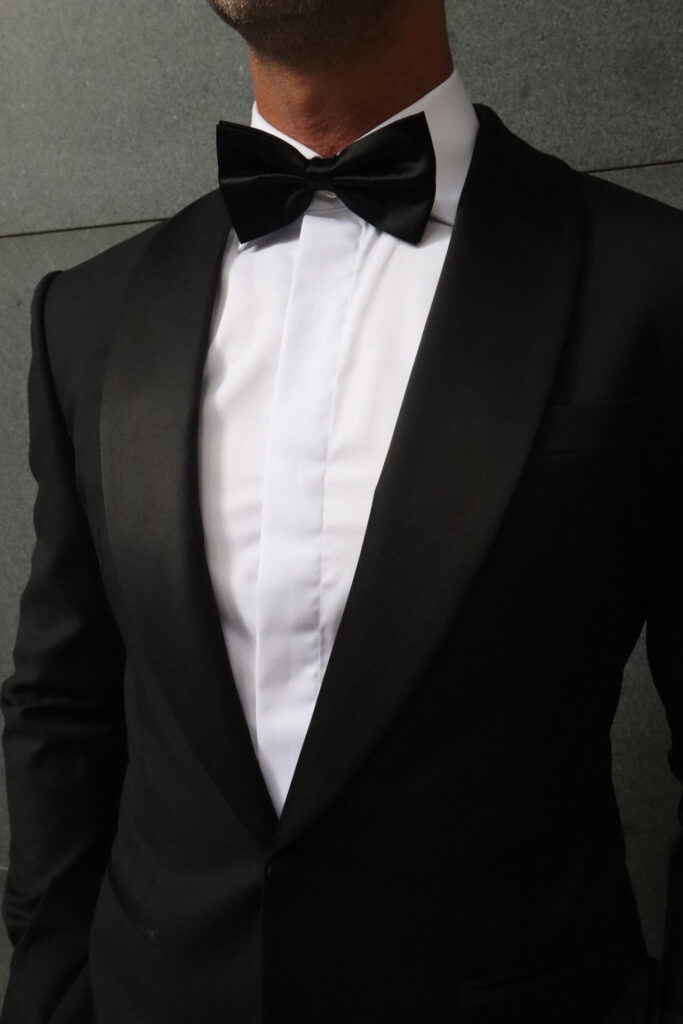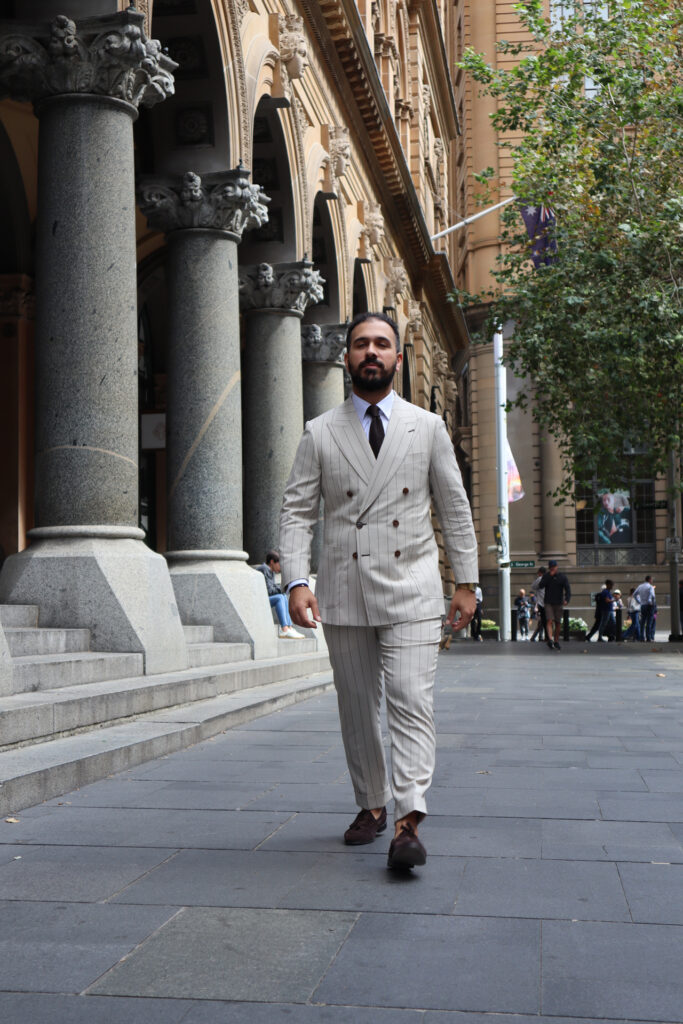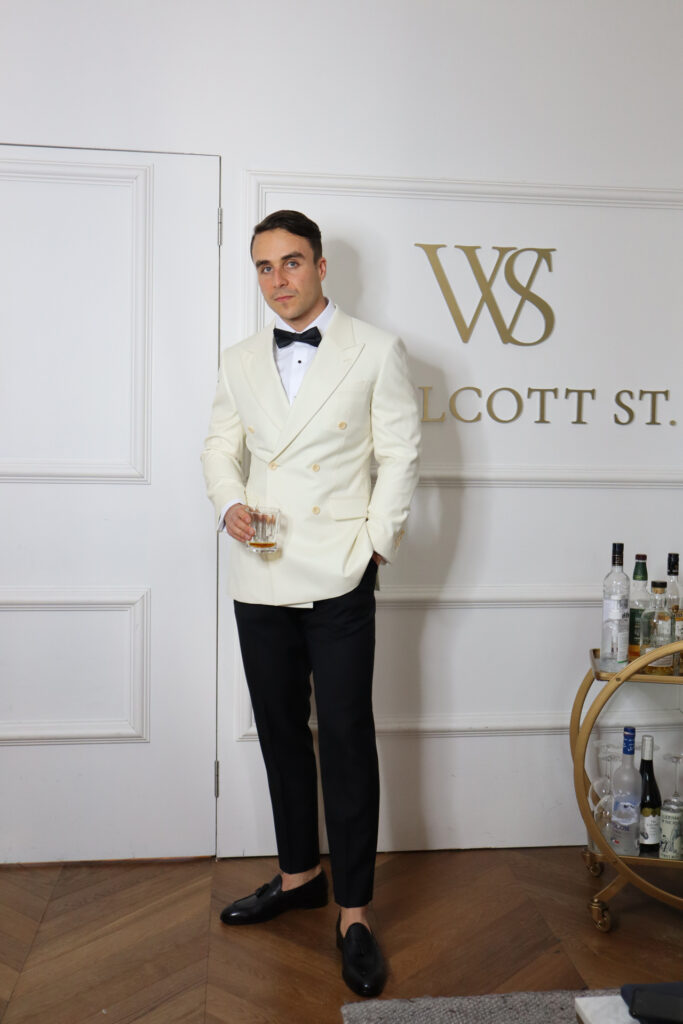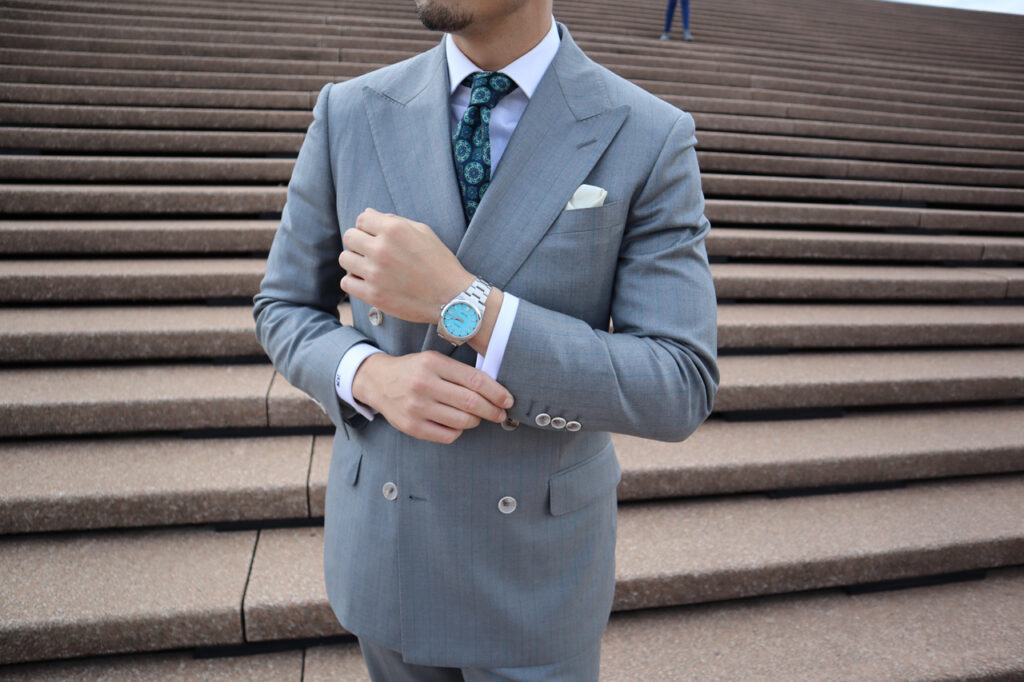Confused about the differences between a tuxedo and a suit? The choice between these two men’s formal wear staples is crucial, as it affects how you fit into the occasion’s atmosphere.
This guide breaks down the differences between a tuxedo and a suit, and offers advice to help you understand this often-subtle distinction. Whether you’re attending an elegant wedding, a formal gala or an important business meeting, knowing the appropriate time to wear each can make a marked difference in your confidence and style.

What defines a tuxedo and a suit?
A tuxedo, often reserved for the most formal events, is distinguished by satin lapels, buttons and black formal trousers. Traditionally worn with a white shirt featuring a wing collar and a bow tie, tuxedos can take your overall ensemble up a notch, helping you exude effortless sophistication.
Suits are less formal and can be paired with a broader variety of shirts and ties. When styled accordingly, they’re also suitable for business meetings, smart casual events and social events. Suits offer flexibility and can be worn with or without a tie, depending on how formal the event is.
Distinguishing the differences between a tuxedo vs. a suit
Choosing between a tuxedo and a suit? Both have their own style and perfect moments to shine — let’s get into the details of what makes each unique, so you can find the right style for your next big event.
1. Material and detailing
- Tuxedo — The classic tuxedo features satin detailing, including satin lapels and satin-covered buttons. This use of satin enhances the tuxedo’s sleek and polished appearance, making it a more formal option. Tuxedos are created primarily from high-quality wool or wool and silk blends, which contribute to their structured and refined silhouette.
- Suit — In contrast, suits are crafted from a broader range of materials. Common suit fabrics include wool, which is favoured for its durability and breathability, as well as cotton, linen and various other fabric blends that offer versatility across different climates and seasons. Suits typically have buttons that are either toned to match or subtly contrast with the fabric, giving them a less formal but highly adaptable look.
2. Shirt and accessories
- Tuxedo — A tuxedo is traditionally paired with a white dress shirt that features a stiff, front bib, tuxedo buttons, and cufflinks. This shirt often has a wingtip collar, optimised for a bow tie. The formal nature of the tuxedo also calls for minimalistic yet elegant accessories, including a cummerbund or a low-profile vest to maintain the sleek profile of the ensemble.
- Suit — Suits allow for greater flexibility in shirt choices. They can be paired with a wide variety of dress shirts in different colours and patterns, making them suitable for numerous occasions. Accessories for suits can vary widely, from a wide variety of ties, cufflinks and pocket squares to more expressive options that can showcase your personal style.
3. Shoes and formality
- Tuxedo — The traditional footwear for a tuxedo would be black leather shoes, which emphasise the outfit’s formality. These shoes are polished or glossy to a high shine, complementing the tuxedo’s sophisticated styling.
- Suit — Suits are compatible with a broader range of footwear. Options include classic leather dress shoes like Oxfords and Derbys, brogues for a touch of detail or even tasteful loafers. For less formal settings, a clean, modern sneaker can be appropriate, providing a contemporary twist on traditional suit wear.

When to wear a tuxedo vs a suit
Choosing between a tuxedo and a suit can greatly impact your appearance at any event. Here’s a brief guide to help you decide what to wear, ensuring you look your best for every occasion.
- Weddings
Tuxedos are ideal for evening receptions or black-tie events, providing a touch of classic elegance.
For weddings with a more personal touch or a less strict dress code, custom suits offer flexibility and can be tailored to fit the theme and atmosphere you desire.
- Other black-tie events
For events labelled as black-tie, tuxedos are generally expected. They uphold the traditional standard of formal attire, reflecting a sense of ceremonial significance and respect for the event.
When attending less rigidly formal but still upscale events, such as charity dinners or awards ceremonies, a dark, well-tailored suit or a three-piece suit can be perfectly appropriate and stylish.
- Business functions
Business suits are the standard for most work-related functions, whether it’s a day at the office or a business dinner. While the formality of your suit is usually dictated by your workplace — for instance, lawyers are more bound to formalwear, whereas real estate agents may have more flexibility — a suit in a conservative cut and colour is appropriate for high-stakes meetings or upscale evening networking events that require a polished appearance. Alternatively, you can opt for a forest green or dark brown suit and enhance the look with accessories.

Suits vs tuxedos across seasons
Choosing the right attire for different seasons means understanding how fabrics, colours and styles will work in varying climates and settings.
Here’s when you should opt for a tuxedo vs a suit, ensuring you remain comfortable and properly dressed, whether the event is in the heat of summer or the cold chill of winter.
For summer events
While traditionally reserved for more temperate settings, a light-coloured tuxedo (think white or light grey) made from breathable materials like lightweight wool or silk can be perfect for formal summer evenings. These options help maintain elegance without compromising on comfort during warmer months.
Summer suits benefit from lighter materials such as cotton and linen, which keep you cool at less formal events like daytime weddings or business casual meetings. A suit’s versatility makes it ideal for a variety of summer occasions, allowing for a range of styles from relaxed to semi-formal.
For winter gatherings
In winter, opt for a tuxedo crafted from heavier wool to provide warmth while attending formal events. Darker colours such as classic black, midnight blue or charcoal are appropriate choices that blend well with winter’s formal atmosphere. For extra warmth, you can layer with an overcoat, which is perfect for chilly outdoor events.
Winter suits should also utilise heavier materials like thick wool or tweed. These fabrics are not only practical for staying warm but are also stylish and suitable for everyday business wear and semi-formal events. The richness of tweed or the sleekness of heavy wool in a suit offers both functionality and fashion.
For springtime occasions
Spring is the perfect time to infuse lighter colours and materials into your wardrobe. Suits made from medium-weight fabrics like lighter wools or blends provide comfort and style without the heaviness of winter materials. Popular colours include light greys, blues and even subtle patterns to reflect the freshness of the season.
For formal events in spring, a classic black tuxedo is still a stylish choice, but you might also consider lighter shades like charcoal or midnight blue. These colours can offer a softer look appropriate for spring’s lighter days and are just as elegant for evening events.
For autumn festivities
For autumn, you might want to consider a tuxedo in rich, warm tones such as burgundy or navy. Autumn is perfect for suits in transitional fabrics like lighter wool or blended fibres that offer adaptability in fluctuating temperatures. Earth tones such as browns, olives and deep greys are stylish and appropriate for both professional settings and social outings during autumn.

Elevate your style with Woolcott St.
Are you still unsure about the difference between a tuxedo vs a suit or what to wear for a less formal event but want to convey a polished look? Our team is ready to guide you through any questions or concerns you might have.
Book a fitting at Woolcott St. and let our expert tailors craft the perfect ensemble for your next event. Whether you’re looking for a sleek tuxedo for a gala or a versatile suit for day-to-night sophistication, contact us today to get started.


